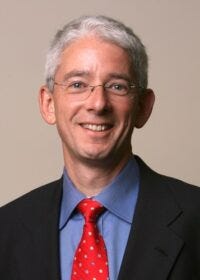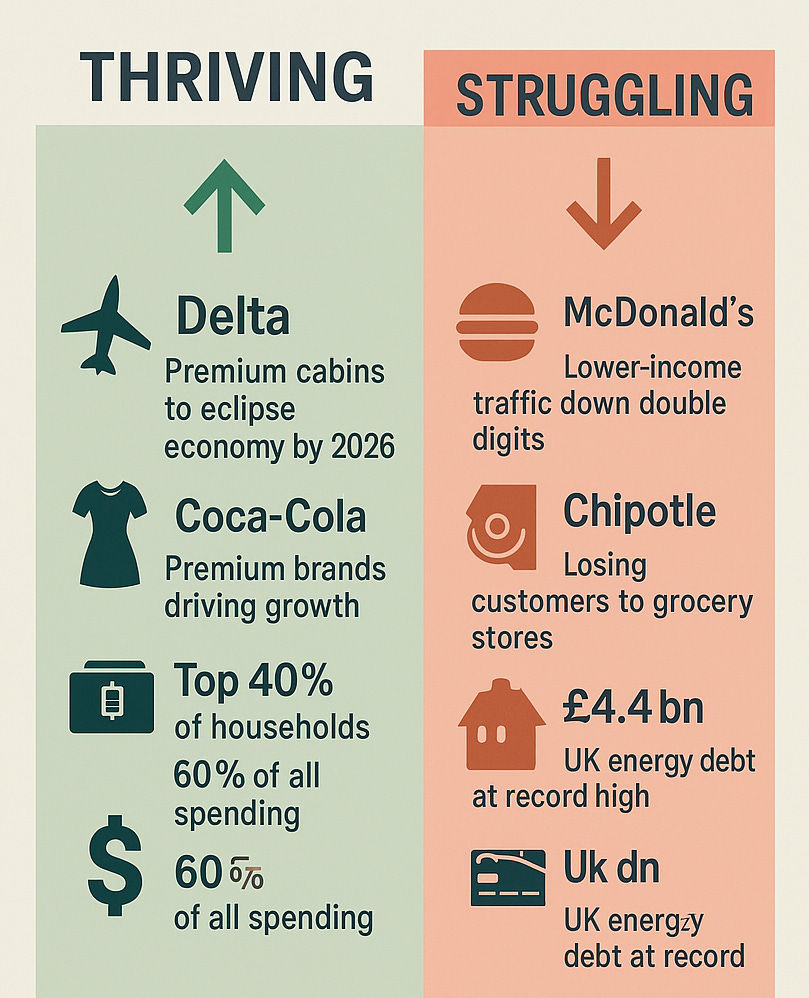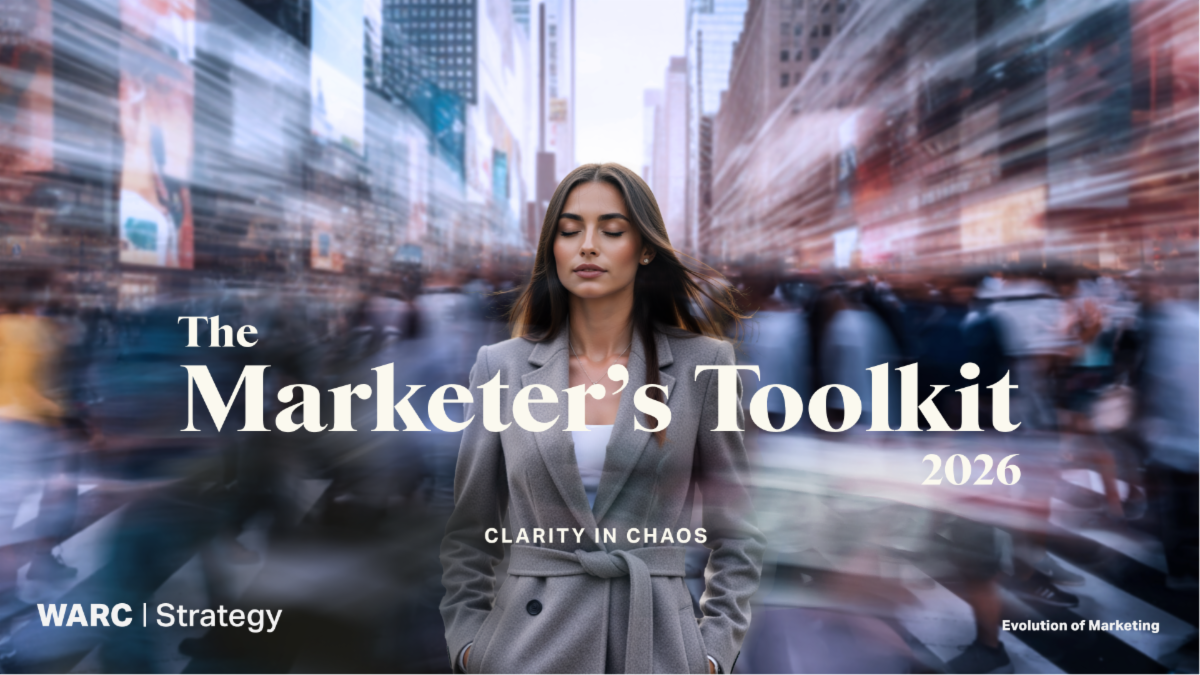The K-Shaped Economy: When Recovery Splits Along Wealth Lines
From Cannes Lions to corner shops, the economic divide reshaping marketing strategy
Last week, I explored WARC’s Marketer’s Toolkit 2026, which revealed that 73% of marketers agree the term “middle-class” is becoming meaningless. This week, I wanted to understand the economic forces driving that statistic. What I found explains why traditional marketing segmentation is breaking and why it’s not coming back.
The letter K has become shorthand for what’s happening across developed economies. One arm rises sharply—soaring asset values, strong spending, prosperity. The other falls—stagnant wages, mounting debt, squeezed consumption. Unlike previous recoveries where all boats eventually rose, this one splits along wealth lines, creating two distinct trajectories pulling in opposite directions.
The data is stark. In the eurozone, the top 10% of households hold 57.4% of total wealth whilst the bottom 50% own just 5%. In the UK, the richest 10% hold 43% of all wealth; the poorest half own 9%. Germany leads Europe in wealth inequality with a Gini coefficient of 0.68.
Peter Atwater, the economist who popularised the term, argues that everyone’s missing the point.
What we have today is a small group of individuals who feel intense certainty paired with relentless power control—and on the other, it is a sea of despair. And that’s the piece that never gets talked about.”
Peter Atwater, Economist, William & Mary
Where Wealth Meets Reality
The Financial Times’ Unhedged podcast recently asked whether the K-shaped economy is real. The question itself reveals the disconnect: companies report wildly different consumer behaviours by income level, yet central bank data suggests incomes haven’t diverged as dramatically.
The answer lies in wealth, not wages. In the UK, the poorest fifth now spend 39% of their income on housing, up from 30% two decades ago. The UK’s wealth Gini sits at 0.59, far higher than its income inequality measure of 0.35. Financial wealth is even worse, with a Gini of 0.87.
Across Europe’s major economies, Germany records the highest wealth inequality at 0.68, followed by France (0.59) and the UK (0.58). Even Sweden, often held up as an equality model, shows surprising wealth concentration the legacy of abolished wealth, inheritance and property taxes.
Housing explains much of this. Countries with higher homeownership rates, like Czechia and Slovakia, show lower wealth inequality than those with large tenant populations like Germany and the Netherlands. The Institute for Fiscal Studies notes that in the UK, the gap between homeownership rates amongst top and middle income groups has never been greater.
In the US, where the pattern appears most pronounced, the top 10% now drive 49% of all consumer spending. Morgan Stanley calculates the top 40% control 85% of America’s wealth—two-thirds tied to stock markets that have climbed over 90% in three years. Chief investment officer Lisa Shalett: “That means 90% of the country is only half the consumption.”
What Companies Are Seeing
McDonald’s chief executive Chris Kempczinski recently warned investors about a “two-tier economy” where traffic from lower-income consumers is down double digits. “People are either choosing to skip a meal or choosing to eat at home.”
Chipotle isn’t losing customers to competitors—it’s losing them to supermarkets. Coca-Cola has adapted with a split strategy, seeing strong demand at both dollar stores and premium outlets. Procter & Gamble notes wealthy shoppers buying bigger packs from club retailers whilst lower-income shoppers exhaust their pantries before returning.
Delta provided perhaps the starkest indicator: premium and business travel seats will eclipse main cabin revenue in 2026, a year ahead of schedule. BlackRock’s global chief investment officer captured the squeeze at the bottom with an unusual metric: “Even toothpaste sales are a little weak people are squeezing more out of the tube.”
The Confidence Split
Atwater’s most concerning observation isn’t the economic data—economists have documented rising inequality for decades—but the psychological consequences.
Consumer sentiment data from the University of Michigan shows this clearly. In 2022, when markets declined, sentiment converged across income levels. By late 2025, it had sharply diverged, with the bottom third feeling far less confident than the top third.
This creates dangerous behaviours at both ends. Lower-income groups, feeling powerless, respond with what Atwater calls the “Five Fs”: fight, flight, freeze, follow and fuck it. Meanwhile, the wealthy become blind to risk. “People are blind to risk when we’re overconfident and invulnerable,” he warns.
The top 20% now own 93% of all stock, according to NYU economist Edward Nathan Wolff. Since ChatGPT’s debut, AI-related companies have accounted for three-quarters of S&P 500 returns. As Atwater puts it: “The stock market isn’t the economy. But the economy is the stock market.”
Why Policy Can’t Fix It
Federal Reserve Chair Jerome Powell acknowledged the “bifurcated economy” at October’s committee meeting, noting corporate earnings calls consistently describe consumers at the lower end “struggling and buying less.”
Yet the tools seem inadequate. Former Fed economist Claudia Sahm argues restrictive monetary policy hits constrained households hardest. Mark Zandi counters: “The Fed can’t fix the K-shaped economy. It can only stabilise prices and employment. The distributional effects are up to fiscal policy.”
In the UK, median household income fell 2% in 2023/24, with the lowest 10% dropping 7%. Rising mortgage rates have pushed 320,000 into poverty. Energy debts hit £4.4 billion, with over a million households behind on payments.
The IFS notes that by 2018, moving from the middle to the top of the wealth distribution required nearly 16 years of typical earnings, up from 10 years in 2008. The rungs keep getting further apart.
What It Means for Marketers
WARC’s 2026 Marketer’s Toolkit found 73% of marketing executives agree “middle-class” has become meaningless, with 59% believing traditional segmentation no longer works. The K-shaped economy isn’t just restructuring consumer spending it’s breaking the assumptions modern marketing was built on.
Those who can afford it seek emotionally immersive experiences McCann Worldgroup projects the “Escape Economy” will hit $13.9 trillion by 2028. Meanwhile, others make grimmer calculations about which meals to skip.
Harvard economist Jason Furman estimates over 90% of US demand growth in early 2025 came from just two GDP categories: information processing equipment and software. The AI boom drives the entire expansion a remarkably narrow base recalling the dot-com era.
Where This Ends
Robert Armstrong of the Financial Times wrote that what makes this moment truly K-shaped isn’t inequality itself developed economies have always had that but “a loss of faith in future earnings among the lower-income cohort.”
That psychological shift matters more than any statistic. Consumer sentiment converged in 2022 when markets fell. By late 2025, the gap was stark: lower-income groups far less confident than high earners about economic prospects.
Atwater’s warning is stark: “Those at the bottom are intensely aware of the overabundance that exists above them. And I’m not sure those above really have any appreciation for what’s happening below the surface.”
For now, the two arms keep diverging. Nobody knows when something has to give.









